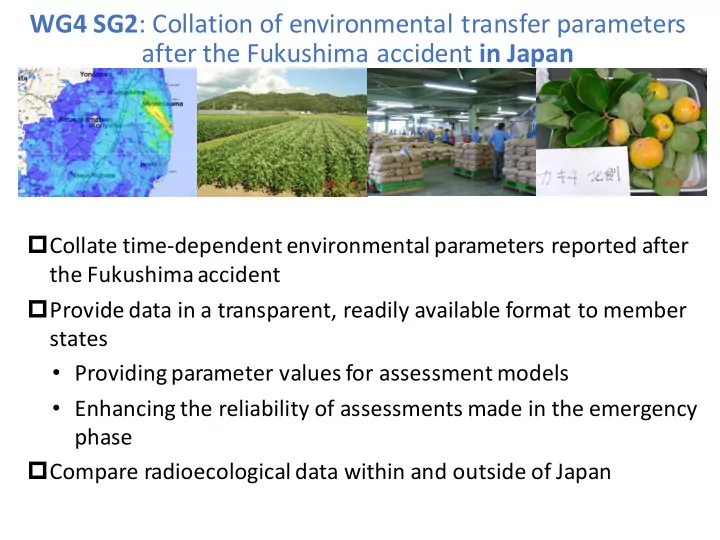

WG4 SG2 : Collation of environmental transfer parameters after the Fukushima accident in Japan Collate time-dependent environmental parameters reported after the Fukushima accident Provide data in a transparent, readily available format to member states • Providing parameter values for assessment models • Enhancing the reliability of assessments made in the emergency phase Compare radioecological data within and outside of Japan
Covered areas of data collation Game Forest Agricultural products Farmland soil Kd Marine River Catchment Transfer to rice, vegetables and crops Transfer to fruit trees and half-lives Agricultural Farm animals Rice product Catchment : Wash-off from various types of land paddy field Food Freshwater : processing Sediment Kd Biota CR and half-lives Forest <= 2018 interim Interception @ Fukushima Univ. Transfer to trees Transfer in trees Edible plants and mushrooms Transfer to game Marine Fish and other biota CR Sediment Kd 2019 interim => Food Processing @ IAEA More than 50 Japanese authors and international scientific contributors
Agriculture Collated time-dependent environmental parameters reported after the Fukushima accident - novel data for some crops not previously considered In agricultural fields, potassium application was of key importance to produce crops with RCs below standard limit.
Forests • Forests represent the largest land use in areas affected by the FDNPP accident (70 % of the areas affected). • Novel data collected on typical dynamics of radiocaesium in forest ecosystems in the early and medium stages after the single deposition event. • Radiocaesium transfer to tree compartments, soil, mushroom, wild edible plants, and game documented.
Catchments Catchments Forests Agricultural field Forests
Freshwater fish Concentration ratio CR (Bq/kg fish FW per Bq/L Fish species Water body N Median AM ASD GM GSD Plecoglossus altivelis River 31 1300 1600 1300 1100 2.9 Hypomesus nipponensis Lake 10 940 1200 760 1000 1.7 Carassius sp. Lake 25 2200 2300 940 2000 1.7 Carassius sp. River 8 1200 1400 840 1200 1.7 Cyprinus carpio Lake 8 1700 2000 910 1800 1.6 Cyprinus carpio River 8 1000 2200 2300 1400 2.7 Tribolodon hakonensis Lake 26 2500 2500 1200 2200 1.8 Tribolodon hakonensis River 46 920 1100 690 820 2.3 Oncorhynchus masou Lake 8 2200 2300 1500 1600 3.3 Oncorhynchus masou River 22 700 1400 2300 650 3.6 Salvelinus leucomaenis Lake 16 4500 4400 1600 4100 1.5 Salvelinus leucomaenis River 2 2900 2900 3800 1000 11 Anguilla japonica River 21 2500 3000 3000 1800 3.4
Marine CR values fo for fish Black rockfish ( クロソイ) , Pelagic 10000 1000 CR 100 10 1 Japanese flounder ( ヒラメ ), Benthic 10000 1000 100 10 1
Marine systems CR ・ Pre-accident CR values for equilibrium conditions ranged from 10 to 100 L/kg, depending on species and their body size. ・ PeakCR a values postaccident are converging to pre-accident values with half life of 200-1200d. ・ Variation in half lives due to distribution of 137 Cs in seawater, ongoing 137 Cs-inputs, and differences in habitat. K d • Long-term monitoring suggests K d values have site-specific, event- specific and time-dependent characteristics. • A mathematical model showed that after the FDNPP accident, K d values will not return to pre-accident levels • It is important to quantify factors controlling the variability of K d for prediction of the fate of man-made radionuclides in the environment.
Fukushima TECDOC progress • Chapters reviewed • Some main messages are; • Time dependent environmental parameter data compared with pre-accident data • Some region specific data enhanced compared with TRS 472 and TRS 422 (marine and freshwater fish CR, Rice, Wild edible plants) were enhanced. Next steps • Next month - Revision of text by authors; external review. • Aim to publish the data in 2021 - 10 th anniversary after the Fukushima accident.
Proposal: Fukushima accident scenarios and model testing • Development of selected Scenarios using FDNPP data • Blind model testing • Comparison of model outputs with undisclosed data • Discussion of variance of models with data • Remediation?
SG 3: Non-temperate systems Report: Soil-plant transfer of radionuclides in non-temperate environments Agreed deadlines for the final draft report: Q2 2020 ✓ Databases now finalized for both arid and tropical environments, data analysis not yet completed; ✓ Agreement reached on approach for analysis of the two datasets; ✓ Agreement reached on the presentation format of tropical and arid databases within the report; ▪ Separate work on drafting report text following the chapters structure proposed at interim meeting this year in Morocco; ▪ Discussion on the draft of a potential CRP proposal on “ The behaviour of radionuclides in arid and semi-arid environments for radiological environmental impact assessment ” – agreement on project objectives and activities; ▪ Discussion on plans for the future programme.
Tropical database Radionuclide and heavy metal data compiled from over 100 source references and representing: • >150 plant species • >5000 sample measurements • 15 countries • 33 elements
Proposal: Testing models and model parameters for assessments in non-temperate environments RATIONALE • Unique environmental conditions (arid and tropical) • Current and planned nuclear fuel cycle activities (U mining, NPPs, waste disposal) • Climate change – potential for expansion of non-temperate zones AIMS • To conduct scenario-based testing of the efficacy of assessment models • To identify the model parameters and assumptions that are potentially influenced by regional environmental/climate conditions • To better understand the uncertainty
Recommend
More recommend